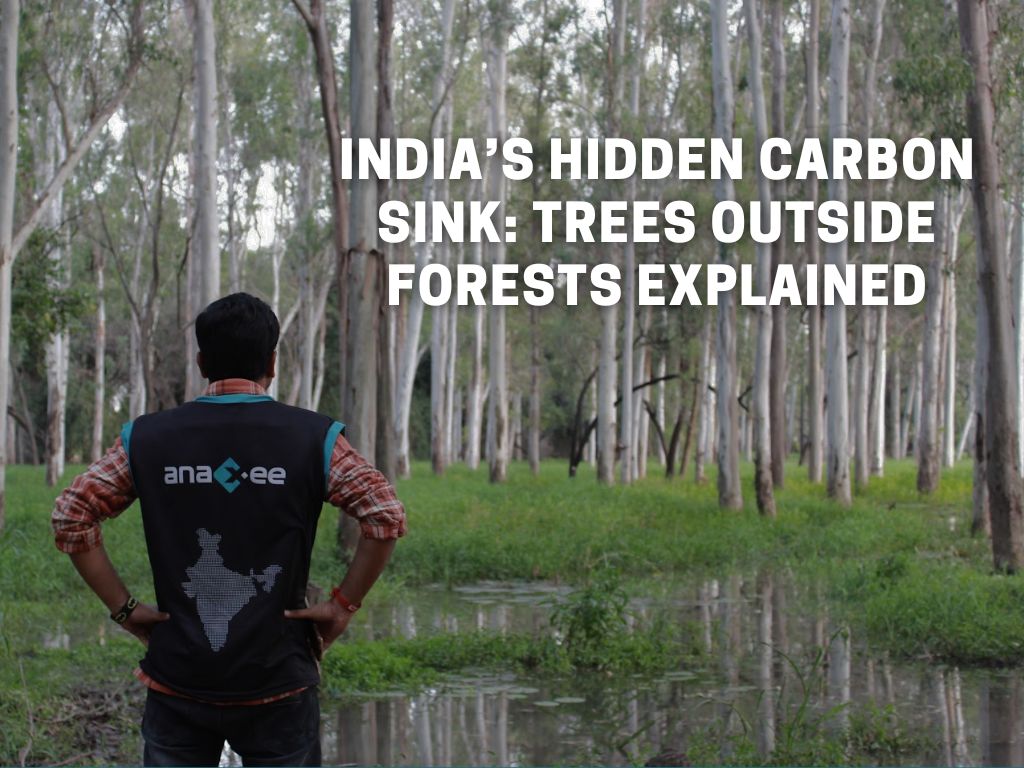BLOG

Carbon-Grade Tree Plantation: How India’s Trees Outside Forests Super-Charge Climate Action & CSR Impact
India’s Hidden Carbon Sink: Trees Outside Forests Explained
1. A nine-percent green cushion India can’t ignore
India’s Trees Outside Forests (TOF)- all trees outside the legal forest boundary- already cover 29.38 million ha, 8.94 % of the nation’s landmass. They store an astonishing 2 531.8 million tonnes of carbon, roughly 38 % of all carbon held by India’s forest-and-tree cover . In climate terms, that is India’s single largest “sleeping sink,” soaking up emissions equivalent to the entire annual footprint of the European Union.
| Metric | Figure |
| TOF extent | 29.38 M ha |
| Share of India G.A. | 8.94 % |
| Total carbon stock | 2 531.8 Mt |
| Potential annual timber yield | 85.16 million m³ |
2. Environmental dividends that go far beyond tonnes of CO₂
TOF resources deliver a multi-layered suite of ecological services:
-
Soil & water security- tree roots cut erosion and shield watersheds from siltation.
-
Biodiversity corridors- scattered and block plantations knit fragmented habitats, vital for pollinators and small fauna.
-
Micro-climate stabilization- canopy cover tempers heat extremes, a blessing for India’s rising urban heat-island index.
-
Desertification control- windbreaks along canals, roads and farm bunds arrest sand drift in semi-arid belts.
-
Livelihood resilience- fuelwood, fruit, fodder and timber diversify farm income, backing rural food security.
3. What makes a plantation carbon grade?
We define a carbon-grade tree plantation as one that:
-
Maps to an FSI 5 × 5 km TOF grid, ensuring verifiable baselines.
-
Falls within FSI’s recognized categories—block, linear, scattered, agro-settlement, roadside, rail, canal or wasteland.
-
Uses species with published volume equations (e.g., Mangifera indica, Azadirachta indica).
-
Commits to periodic stock inventory identical to FSI’s methodology, making carbon deltas credit-ready.
Result? Transaction costs plummet and carbon credits become bankable within one verification cycle.
4. Climate-mitigation math you can’t afford to miss
Planting one hectare of mixed-species TOF bunds adds ±80 t CO₂e over 30 years.
Scale that across even 10 % of the 43.16 million ha of plantable non-forest land India has identified , and you unlock a future sink of ≈345 Mt CO₂e—a full 14 % of India’s Paris-pledged extra sink by 2030.
5. Where should private capital focus first?
Image Credit- FOREST SURVEY OF INDIA
| Site class | Carbon upside | Environmental co-benefit | Data proof | Why corporates? |
| Culturable wasteland | Highest hectares available | Reclaims degraded soil | FSI wasteland overlays | Land is cheap; CSR-fundable |
| National / State highways | Linear forest corridors | Road-safety shade + dust buffer | Geo-referenced road layer | Visibility for brand ESG |
| Rail corridors & sidings | Low conflict footprint | Noise & windbreak | Rail GIS shapefiles | Long-term leases possible |
| Canal banks | Moisture rich, fast growth | Reduce evaporation | Irrigation dept. maps | Shared maintenance budgets |
All four are specifically recommended by the FSI’s plantation approaches to lift carbon stock.
6. Species that maximise both carbon and revenue
| Species | Share of rural TOF volume | Added value |
| Mango (Mangifera indica) | 12.7 % | Fruit + timber; cultural icon |
| Neem (Azadirachta indica) | 8.1 % | Bio-pesticide market |
| Acacia (A. nilotica) | 4 % | Durable poles, fodder |
| Coconut (Cocos nucifera) | 3.4 %† urban | Coastal carbon sink |
Smart mix: pair high-density mango with nitrogen-fixing acacia for a resilient, carbon-heavy canopy.
7. CSR & private investment: the triple win
India’s Companies Act mandates that 2 % of average net profits flow to CSR. Tree planting is an approved Schedule VII activity. By adopting carbon-grade tree plantations:
-
Emission targets- claim third-party verified removals, not vague “green clubs.”
-
Community goodwill- farmers gain diversified incomes from timber and NTFP yields (annual timber potential hits 85 m m³ nationally).
-
Brand equity- visible, GPS-tagged plantations show up on dashboards that global buyers audit for Scope 3 supply-chain disclosure.
8. Conclusion- plant where the math, the planet and profits align
India’s TOF estate is already a giant carbon sponge. Scale it by even a few million hectares of carbon-grade tree plantations and you create an environmental flywheel: deeper rural livelihoods, cleaner air, cooler cities and a Paris-aligned carbon sink. Corporate CSR boards and global impact investors have a once-in-a-generation chance to write their names- literally- into India’s green map.
Ready to talk hectares, tonnes and timelines?
Reach out to Anaxee Climate Services for a rapid opportunity scan and see where your capital can plant the next climate dividend.
FAQs:
Q. What are Trees Outside Forests?
All trees beyond India’s recorded forest area- farm bunds, roadsides, canal banks, rail verges, urban parks and homesteads.
Q. How much carbon do they hold now?
About 2 531.8 Mt, combining 1 595.7 Mt in forest cover patches and 936.1 Mt in tree cover .
Q. Why “carbon-grade” matters?
FSI-aligned plots, species and sampling make credits defensible; buyers pay premiums for transparency (see Section 3 above).
Q. Is extra land really available?
Yes—FSI’s NDC study cites 43.16 million ha of plantable area on wasteland, highways, canals and agro-corridors .
Q. Top states to start?
Maharashtra (234.6 Mt carbon), Odisha (206.7 Mt), Karnataka (195.3 Mt), Madhya Pradesh (195.9 Mt) and Uttar Pradesh (135.8 Mt) lead the current stock league.
Q. Which species finish projects fastest?
Fast-growing poplar for short rotations, but mango and neem balance carbon, cash and co-benefits.
Q. What’s the MRV cost benchmark?
Digitised, grid-synced sampling can cut typical field audit budgets by >30 %; Anaxee’s hybrid model leverages existing Digital Runner network (internal data).
Q. Can harvested wood still count?
Yes. Harvested wood products continue to store carbon; re-planting keeps the sink net-positive, as reflected in FSI’s potential yield tables.
Q. How soon can CSR boards report impact?
Baseline + planting year = Year 0, first growth audit typically in Year 3, credit issuance depends on methodology but early claims (ex-ante) can appear in sustainability reports immediately.
Q. Is this eligible for international finance?
Alignment with FSI data and India’s NDC road-map positions projects for Article 6 or voluntary market transactions. Global buyers increasingly prefer removal credits tied to strong national inventories.
Next step?
Book a free 30-minute TOF scoping call with Anaxee. We map your landbank, run a carbon forecast and outline an MRV budget in under a week.
Reference: All quantitative data and methodological descriptions are sourced from Forest Survey of India, “Trees Outside Forest Resources in India,” Technical Information Series Volume 2, No 1, 2020





